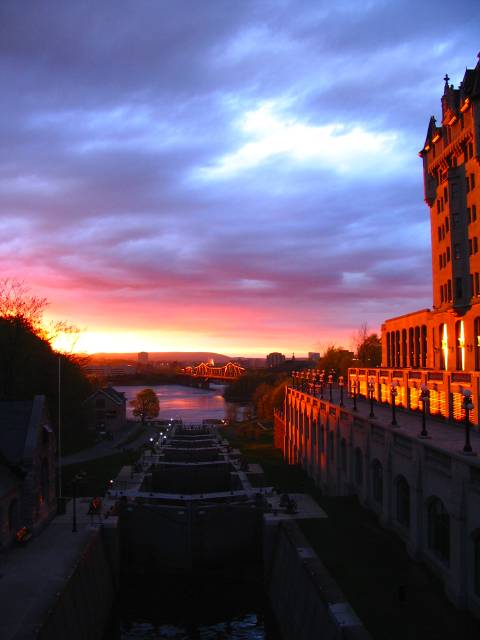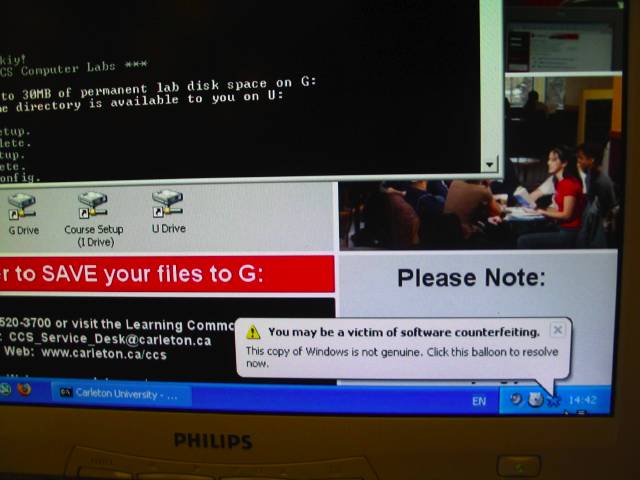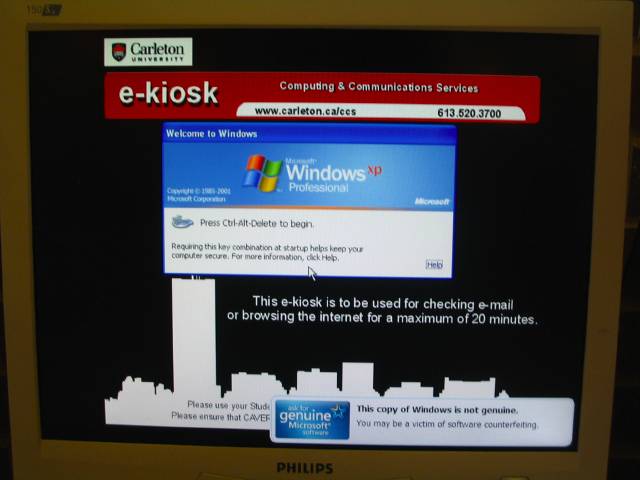I’ve been a member of National Capital Freenet for about 11 years. For about a year prior to getting an account on Freenet, I were using vt320 terminals at Ottawa Public Library and were logging in as guest to read the newsfroops. At some point I got the parents and guardians involved, and they co-signed on my behalf, and I got my own freenet userid: cn119.
Freenet changed over years. Originally it was a primarily text based service, with ability to dial in for up to half an hour a day using PPP on 9600 modem, and connect to internet. Freeport software was the primary means of interaction with the system. It had a god awful e-mail interface, with pico to compose e-mails (nothing like introducing new users to bad unix habits, right? ) until Mark Mielke finally hacked together elm and duct-taped it onto FreePort. FreePort had a bunch of holes – San Mehat at one point showed me that one can drop to a real shell. I seem to recall that it was possible to trick early versions of lynx to execute a real shell on NCF as well, but this was 10 years ago, so my memory is hazy.
In any event, before I started at iStar, and had a real newsfeed (Thank you, John Henders@bogon/whimsey, wherever you are. Heck, thank you to all the folks at iStar NOC, and DIAL. Oh, and Jason “froggy” Blackey, for sure. And Tim Welsh. Jeff Libby. Steven Gallagher, whom I must have given plenty of white hairs. Most defintely GJ/Jennifer tag team. And Mike Storm. And farewell, Chris Portman), NCF was my primary way of reading alt.sysadmin.recovery. For a while, many moons ago cn119@freenet.carleton.seeay was my primary e-mail address.
I guess this is over by now.
Partying was somewhat bittersweet.
A few years ago NCF got swamped by spam. I remember having to delete ~700 spam messages a day. Some sort of mail filtering solution was implemented – I never really cared, as by that point I weren’t using NCF e-mail for anything, but spam stopped. A couple years later I’ve noticed that all mail kind of stopped too.
(In retrospect, to the best of my current understanding (and I really don’t care), a dedicated procmail system was implemented, and in turn was filtering to the POP3 accessable mail queue on a dedicated system, or somesuch. And, of course, I’ve never checked pop3 mail queue, and for years weren’t aware of it’s existance. Telnet, baby, telnet).
By ~2002 the only thing I were using NCF for were newsfroops, as I could read ott.forsale.computing alot more efficiently through a real newsreader then through a web interface.
I guess I should mention that NCF operates on donations. Every year one is expected to donate some money to keep NCF running. In order to do that, NCF accounts expire every year, and one has to go to Dunton tower at Carleton to renew them, and, hopefully give them some money. Every year I’d donate between 20 and 50$, and even after e-mail renewal notices stopped coming, for a couple of years I’d be on Carleton campus writing a final, and remember to stop by, and remind folks at NCF that I am still around and still care. One day I’ve asked if one has to donate in order to get one’s account renewed, but turned out that no, one can donate nil, and still keep on using Freenet. Hrm. Then why expire accounts, then? It’s so you would remember to donate.
This year I’ve forgot to renew my account.
So last Thursday I’ve logged in, only to see
cn119@134.117.136.48's password:
Last login: some date from some ip address.
Sun Microsystems Inc. SunOS 5.8 Generic Patch October 2001
-------------------------------------------------------------------------
This National Capital FreeNet | Le compte de cet usager du
user account has been archived. | Libertel de la Capitale Nationale
| a ete archive.
NCF Office / Bureau LCN : (613) 520-9001 office@freenet.carleton.ca
-------------------------------------------------------------------------
Connection to 134.117.136.48 closed.
That morning I were at work, in a dark basement with no cell phone coverage, and someone on the phone convinced that I care about the fact that his blueberry iMac’s power supply failed, and will find him a replacement power supply for cheap. Why do I always get cheap customers?
So the plan was to look for something similar on ott.forsale.computing, and failing that, order a replacement G4 chassis from CPUsed in Toronto. This is where the plan didn’t go as planned, as I couldn’t log in into NCF.
So, logically, one should ask someone at NCF to “unarchive” my account (in practice, change my login shell back to FreePort, as I know that my home directory is still there, as I can access http://freenet.carleton.ca/~cn119/ and see the same old junk that was there for the last 7 or 8 years.), and promise to stop by in person and give NCF more money.
I’ve called the above number, only to hear it ring, and be told that noone is around to answer my call, and I should call 520-5777. Oh, and I could leave voice mail.
So I’ve called 520-5777. It rang once, and then told me that noone is available, and that I should leave voice mail. I’ve hanged up, and called again in 5 minutes. Same result. After calling over and over in 5 – 10 minute intervals seven times, I’ve left voice mail. I identified myself, and the problem I were experiending. In it I’ve pointed out that I am unimpressed by lack of warning regarding account expiry, and unimpressed that I can’t talk to a human being about it. I mentioned that I am not sure that anyone will call me back, and that’s why I am not really happy with voice mail. I’ve pointed out that I don’t have coverage where I am, so they will have to leave voice mail when they call back. If they call back. I guess I were overly snarky in my message.
Around 4 pm I got out of the basement for a breath of fresh air. My cell phone chirped with “new message” message, and I learned that I have new voice mail. Voice mail was from Brian at NCF, and ran for over 7 minutes. In it Brian (or Ryan) was telling me how busy he is, how Freenet has over Eight Thousand members and by talking to me he is not talking to someone else on the phone, and how upset he is with me, etc. Main idea of the message was that I should come in person to Dunton Tower.
Frankly I weren’t impressed by this point. I were expecting one of “Your account is renewed, do stop by and remember to donate” or “Stop by Dunton tower, we will renew your account then”. Instead I got 7 minutes of telling me how busy someone is and how bad I am for taking Ryan (or Brian) away from answering phones, and how ungrateful I am for not donating so that Brian could be hired full time.
While listening to it, I had a WTF moment. Admittedly it wasn’t the first one of the day, as I get WTF moments at work all the time, but still….
So next day I’ve stopped by NCF offices at Carleton’s Dunton tower in person. I got to observe Brian in his natural habitat. Frankly, he reminded me of someone…. Of myself, about 10 years ago. Back when my ego was bigger, and was more easily bruised. Back when I thought that I am really hardcore, and everyone else is less so.
For about 10 minutes I’ve listened how Brian was talking to someone who sounded like a shut-in in search of human interaction, and tried to explain to him where to click. I hear conversations like this at work all the time – they are the bank breakers, as a technican spends a good hour or two hand-holding someone with no financial renumeration at all. Talking for an hour to someone, who has limited grasp of computing, and at the end telling him to see if he has a friend with some other ISP dial-up account, who will let him try his phone number and user id to see if the software will recognize a modem and will successfully negotiate PPP? Why not cut one’s losses, and talk to any of the other people in the call queue, and maybe actually help them?
Eventually Brian and I had a conversation. It didn’t go over too well. Brian was reluctant to do anything, however he repeatedly pointed out that he is not answering the phones while talking to me.
He pointed out that NCF serves over 8000 members. I’ve mentioned that I don’t find that all that impressive, because around 1997 they had 30000 active members, and seem to just be hemmoraging users over the last 10 years. I remember when ‘w’ on freeport would list pages and pages of logged in users, not about 20 users (10 of which would be xxnnn accounts, which are the accounts of freenet volunteers) that it shows now. In other words, FreeNet’s 8000 users is nothing. Cyberus has many more. iStar had about eighty thousand users when I worked for them.
Brian mentioned that the reason NCF doesn’t have a hold queue is because there is voice mail. He expanded upon it by saying that he is not the kind of person that would call department of transportation, but would go there in person. I wondered if he realized that the time that they spent talking to him in person they could have spent answering someone on the phone.
Brian also pointed out that NCF was the first ISP in Ottawa, if not in Canada. I am not too sure, and pointed out that resudox.net (I happened to know Steve Birnbaum, in another life) started in 1993 too, maybe even earlier. Brian snorted, and asked where resudox is now. Heck, if I’d have rent-free space, donated bandwidth, servers, phone lines, modem racks, etc., I’d also be around for years. Somehow noone else has such advantage, and thus actually have to make money somehow.
Ot was obvious that we weren’t seeing things eye to eye.
At that point I’ve asked him directly if he can renew my account, and he told me that matter will be refered to the executive director of NCF, John Selwyn, for review. Only he can renew my account.
I’ve called John, and left him voice mail (note a common theme in my dealings with NCF?) Yesterday I’ve stopped by offices 2018 and 2019 in Dunton Tower, to see if he might be in, and I could talk to him.
So far no answer.
I am not holding my breath.
Frankly, if all the complaints about lack of funding made by Brian are true, NCF loses more by losing yet another member, who was donating. I can use groups.google.com.
Farewell, NCF. It was a long ride, but I guess it’s over now.
In any event, I want to thank all folks who at one point made NCF great, and whom I more, or less knew.
Paul Tomblin, NCF’s newsadmin. I forgot by now what it is that Paul helped me out to with many many years ago, but the feeling of grattitude remains. But NCF news server works, and I am not upset that it doesn’t carry alt.binaries 😛
Ian! D. Allen. formerly technical director of NCF. I’ve interacted with him many a time at OCLUG meetings.
Mark Mielke, who, besides hacking NCF, also hacked LCInet at Lisgar. Lisgar was a melting pot of folks. I’ve met Sierra Bellows at Lisgar too. She is a step-daughter of Ian! D. Allen. Somewhere I have a CD with her singing from 1995 or so. Small world.
Roy Hooper, who gave up on running NCF, and instead ended up running Cyberus (and hiring me to run Cyberus instead), and, now, I’ve heard, runs CIRA. Roy used to be NCF’s sysadmin.
GJ Hagenaars, who also gave up on running NCF, and instead ended up running DIAL at iStar (and hired me “to write technical documentation. Part time.”). GJ was NCF’s Postmaster, and, coincidentially, is responsible for my hate of sendmail and love of exim.
Jennifer Witham, who was right, and in her “tough love” way very supportive. Jennifer, you were right, you hear. I were wrong. Oh, Jennifer was a volunteer of the month, back in 1997.
Pat Drummond, for always being helpful, and Chris Hawley, I guess also for being helpful. By now I forgot what it is that Chris Hawley did, and it might have been minor, like changing permissions on something in my ~, but it was a huge deal back then, and feeling of grattitude remains.
Thank you, folks.





